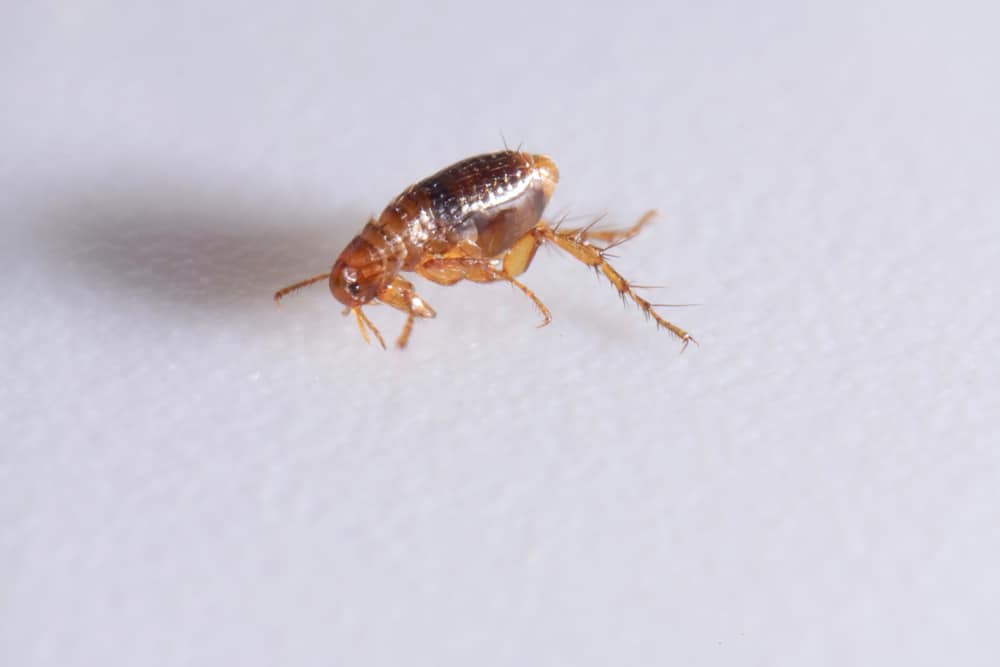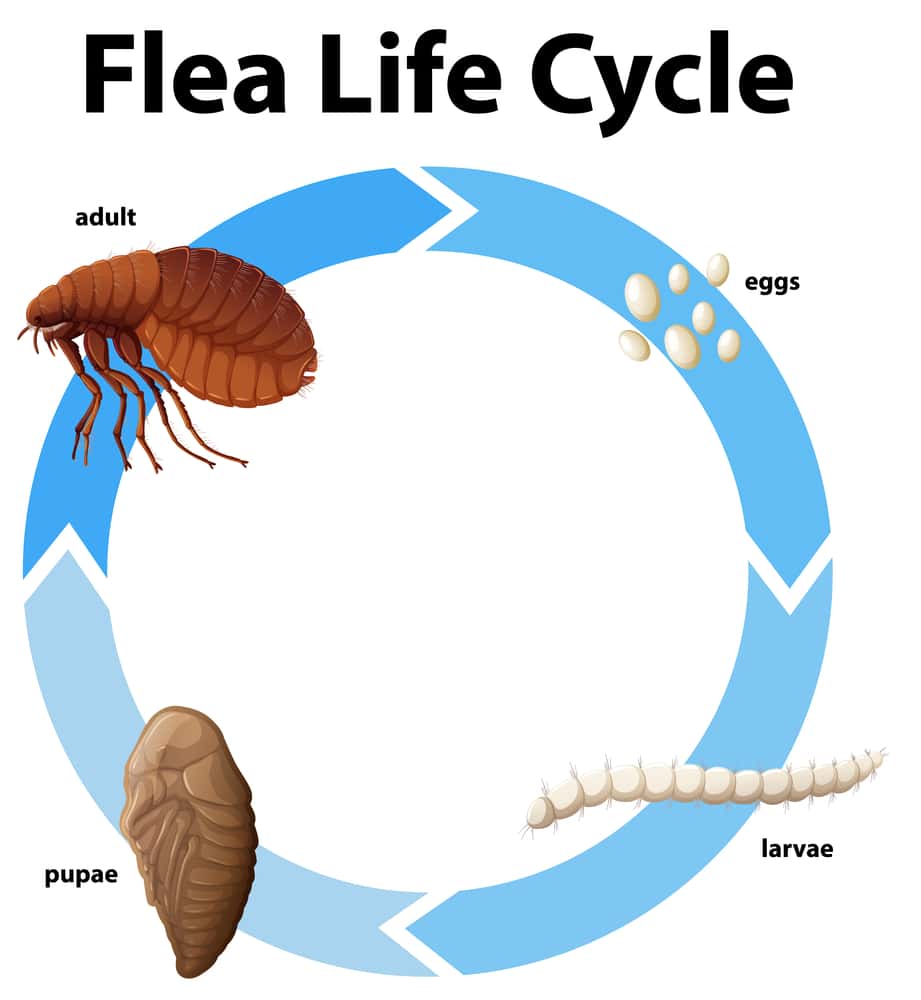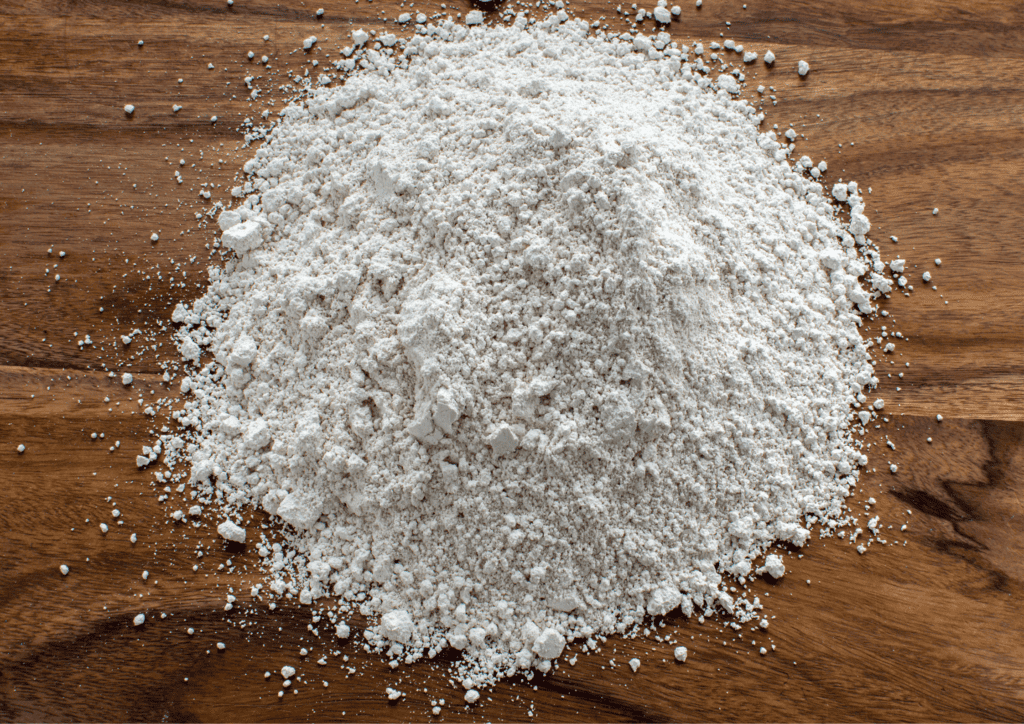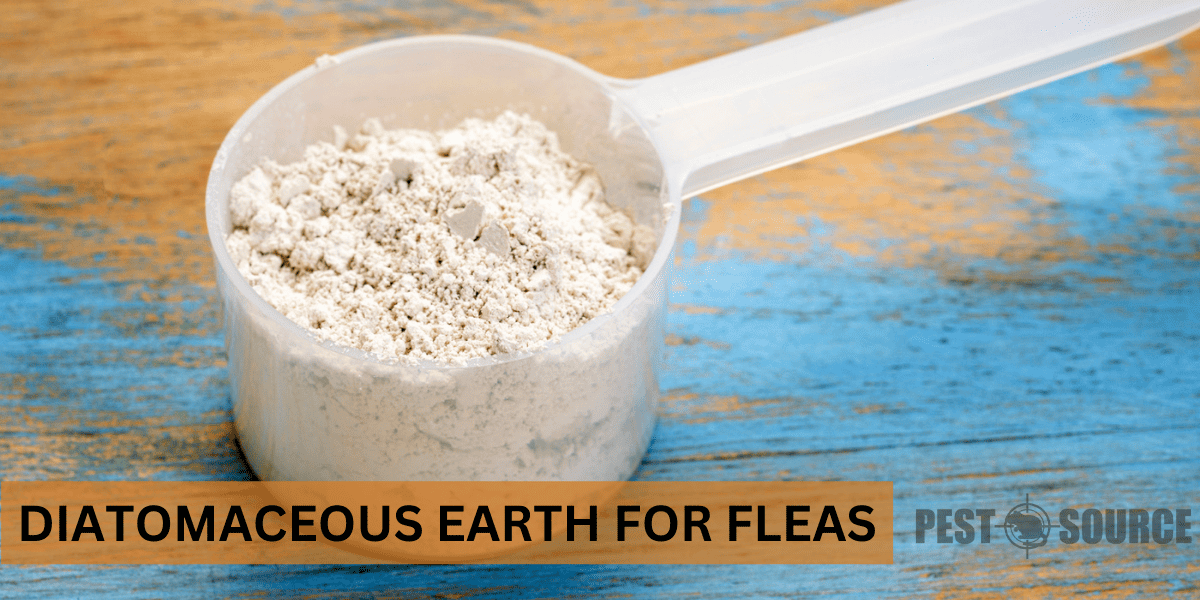Fleas are tiny parasites that cause a myriad of problems for both pets and humans, ranging from constant itching and irritation to severe allergic reactions and disease transmission. Finding an effective method to control fleas is essential for maintaining a healthy and comfortable environment for both you and your pets. One natural solution that has gained popularity is diatomaceous earth. In this article, we’ll explore what diatomaceous earth is, how it works, and its effectiveness in controlling fleas.
POINTS
- Diatomaceous earth is a natural, low-toxicity alternative to chemical insecticides, effective at killing adult fleas by damaging their protective outer layer and causing dehydration.
- Flea control using diatomaceous earth requires targeting all stages of their life cycle (eggs, larvae, pupae, and adults) through thorough and consistent application in various environments such as on pets, in the house, and in the yard.
- Food grade diatomaceous earth is preferred for flea control as it is considered safe for humans and pets, whereas non-food grade diatomaceous earth can be hazardous due to high crystalline silica content.
- While diatomaceous earth can be an effective tool against fleas, it is most successful when combined with other flea control methods like regular vacuuming, pet grooming, and yard maintenance.
- When using diatomaceous earth for flea control, it’s essential to follow safety precautions such as wearing gloves and a mask, ensuring proper ventilation, and keeping children and pets away from treated areas until the powder has settled.
Understanding Fleas and Their Lifecycle
What are Fleas and Why are They a Problem?

Fleas are small, wingless insects that survive by feeding on the blood of animals and humans. They are notorious for their ability to jump long distances, quickly spreading from one host to another and causing infestations in homes and outdoor environments. Fleas are more than just a nuisance, as their bites can lead to allergic reactions, skin infections, and even transmit diseases, such as tapeworms and murine typhus. Consequently, effective flea control is crucial for maintaining the health and well-being of your pets and family.
What is the Lifecycle of Fleas and Why is it Important in Flea Control?

The flea lifecycle is complex, consisting of four stages: eggs, larvae, pupae, and adult fleas. Understanding this lifecycle is critical in controlling an infestation, as each stage has its vulnerabilities and requires specific treatment methods.
- Eggs: Female fleas lay eggs on their host, which quickly fall off and can be found in bedding, carpets, and furniture. These eggs are resistant to most insecticides and require targeted treatments.
- Larvae: After hatching from the eggs, flea larvae feed on organic debris and fecal matter from adult fleas. Larvae are often hidden in dark and moist areas.
- Pupae: Flea larvae spin cocoons, transforming into pupae. These cocoons are resistant to most insecticides, making them difficult to eradicate.
- Adult fleas: The final stage is the blood-sucking adult flea, capable of causing discomfort and transmitting diseases.
To effectively control fleas, it’s essential to target all life stages simultaneously. This is where diatomaceous earth comes into play.
Understanding Diatomaceous Earth
What is Diatomaceous Earth (Also Known as Damascus Earth, Diametric Earth, Dia Earth, and Deciduous Earth)?
Diatomaceous earth is a naturally occurring, soft sedimentary rock that crumbles into a fine, white-to-greyish powder. It is composed of the fossilized remains of diatoms, microscopic aquatic organisms with a silica-based cell wall. Diatomaceous earth has various applications, ranging from pest control and filtration to abrasive cleaning and soil amender.
How is Diatomaceous Earth Classified (Food Grade vs Non-food Grade)?
There are mainly two classifications of diatomaceous earth: food grade and non-food grade.
- Food grade: This type is safe for human and pet consumption and consists of a lower percentage of crystalline silica, making it less hazardous. Food grade diatomaceous earth has numerous health benefits like parasite control, trace mineral supplementation, and detoxifying agents.
- Non-food grade: This type is not safe for consumption due to its high content of crystalline silica, which can cause respiratory problems. Non-food grade diatomaceous earth is used as an abrasive, filtration aid, and in other industrial applications.
For flea control, it’s crucial to use food-grade diatomaceous earth, as it is considered safe for humans and pets.
How Does Diatomaceous Earth Kill Fleas in All Lifecycle Stages?
Diatomaceous earth is a versatile and natural pest control solution that works by targeting the physical structure of fleas at different life stages. Below is a table that outlines its effectiveness against each life stage of fleas, from eggs to adults, and provides insight into how it disrupts their development and survival.
| Life Stage | Effectiveness | Mechanism of Action |
|---|---|---|
| Eggs | Somewhat Effective | Dries out and damages the outer layer, preventing hatching |
| Larvae | Effective | Causes dehydration through damage to exoskeleton |
| Pupae | Limited Effectiveness | Physical barrier may prevent full exposure |
| Adult Fleas | Highly Effective | Damages exoskeleton leading to dehydration and death |
How Does Diatomaceous Earth Kill Fleas and Flea Eggs?
Diatomaceous earth works as a desiccant, meaning it dries out the exoskeleton of fleas and other insects. The microscopic, sharp-edged particles of diatomaceous earth damage the protective outer layer of fleas, causing water loss and subsequent dehydration, eventually killing them. It’s important to note that while diatomaceous earth is most effective against adult fleas, it can also be somewhat effective against flea eggs and larvae by disrupting their development.
How to Use Diatomaceous Earth for Fleas
How to Apply Diatomaceous Earth for Fleas (On Pets, In the House, In the Yard)?
Diatomaceous earth can be used in various places to control fleas effectively. Here’s how to apply diatomaceous earth in different environments:
| Environment | Application Steps |
|---|---|
| Pets | – Ensure pet is dry. – Apply gently, avoiding eyes, ears, and nose. – Massage into coat, focusing on neck, spine, legs, and belly. |
| In the House | – Sprinkle on carpets, furniture, and pet bedding. – Work powder into fibers with a brush. – Let sit for 24-48 hours before vacuuming. |
| In the Yard | – Dust around home perimeter and pet areas. – Apply in dry weather. – Reapply after rain or watering. |
How to Use Diatomaceous Earth for Fleas on Specific Pets (Cats, Dogs)?
While the process is similar for both cats and dogs, each animal might need a slightly different approach:

Cats: Cats are more sensitive to dust, so take extra care to avoid their eyes, ears, and nose while applying diatomaceous earth. Do not apply too much – a light dusting will suffice. Keep an eye on your cat after applying, and if they show any signs of respiratory distress, consult your veterinarian.

Dogs: Ensure your dog is calm and relaxed before applying diatomaceous earth. Hold their snout closed gently if needed to prevent inhalation of the powder. Focus on areas with more fur and folds, like their neck and behind their ears. While dogs are generally more tolerant of diatomaceous earth, still watch for any signs of discomfort or irritation and consult your vet if they arise.
How to Spread and Leave Diatomaceous Earth on Carpet for Fleas?
To effectively use diatomaceous earth on carpets for fleas, follow these steps:
- Remove any clutter, toys, and small items from the carpeted area to ensure thorough coverage.
- Apply a light and even layer of diatomaceous earth on the carpet – you may find using a sieve or a duster with a thin nozzle helpful for spreading the powder.
- Use a broom or brush to work the diatomaceous earth into the carpet fibers gently. This ensures the powder comes into contact with fleas, eggs, and larvae hidden within the carpet.
- Allow the diatomaceous earth to sit undisturbed for 24-48 hours, giving it time to eliminate the fleas.
- Vacuum the carpet thoroughly to remove the diatomaceous earth, dead fleas, eggs, and larvae. Make sure to change or clean your vacuum filter afterward, as the fine powder can clog it.
(Note: You may need to repeat this process several times over a couple of weeks to address all stages of the flea life cycle.)
Efficiency and Effectiveness of Diatomaceous Earth for Fleas
The efficiency of diatomaceous earth in combating fleas depends on various factors, including the life stage of the fleas and environmental conditions. The following table provides an overview of how quickly diatomaceous earth can begin to affect fleas and the factors that may influence its effectiveness.
| Factor | Impact on Effectiveness | Details |
|---|---|---|
| Humidity Levels | Decreases in high humidity | Moisture can reduce the desiccant effect, slowing flea dehydration. |
| Flea Density | Varies | Higher densities may require more thorough or repeated applications. |
| Application Thoroughness | Critical for success | Even distribution and reaching all infested areas are key to eliminating fleas. |
| Time to Kill Adult Fleas | 4 to 12 hours, up to 48 in some cases | Depends on environmental conditions and flea exposure to diatomaceous earth. |
| Effectiveness on Eggs | Limited, but can disrupt development | Damages the outer layer, though not as effective as against adults and larvae. |
Understanding these factors can help optimize the use of diatomaceous earth for flea control, ensuring the best possible outcomes in different scenarios.
How Long Does it Take for Diatomaceous Earth to Kill Fleas?
Diatomaceous earth starts working as soon as it comes into contact with fleas, causing damage to their exoskeletons, which leads to dehydration and death. However, the time it takes to kill fleas varies depending on factors such as humidity levels, flea density, and the thoroughness of the application. Generally, diatomaceous earth might take between 4 to 12 hours to kill adult fleas, but in some cases, it could require up to 48 hours.
How Effective is Diatomaceous Earth in Killing Flea Eggs?
Although diatomaceous earth is primarily effective against adult fleas, it can also have some impact on flea eggs. The dehydrating action of diatomaceous earth can dry out and damage the outer layer of the eggs, preventing them from developing and hatching. However, diatomaceous earth may not be as effective against eggs as it is against adult fleas and larvae, and other methods may be needed to target this stage of the life cycle.
What If Diatomaceous Earth is Not Killing Fleas?
If you find that diatomaceous earth is not effectively managing your flea problem, consider the following:
- Assess your application methods: Ensure you applied the diatomaceous earth correctly and thoroughly, covering all necessary areas where fleas and their eggs may be present.
- Reapply: Diatomaceous earth may need several applications over a couple of weeks to effectively target all stages of a flea’s life cycle.
- Combine with other methods: Diatomaceous earth works well when used in conjunction with other flea control methods, such as vacuuming and regular grooming of your pets.
- Consult a professional: If you’re still struggling to control fleas after trying these approaches, it might be time to contact a professional pest control company for assistance.
Safety and Precautions in Using Diatomaceous Earth
Is Diatomaceous Earth Safe to Use on Pets and Around the House?
When using food grade diatomaceous earth, it is generally considered safe for use on pets and around the house, as its low toxicity makes it a great natural alternative to chemical insecticides. However, there are some precautions you should follow:
- Inhalation: Diatomaceous earth can cause respiratory irritation when inhaled. To avoid this, wear a mask and keep your pets away from the area when applying the powder. Moreover, be cautious when applying it to your pets, avoiding their eyes, ears, and nose.
- Possible skin irritation: Some pets may develop skin irritation from diatomaceous earth. If you notice your pet experiencing discomfort or irritation after application, consult your veterinarian.
What Precautions Should be Taken When Using Diatomaceous Earth for Fleas (Especially Food Grade)?
To safely use diatomaceous earth for flea control, follow these precautions:
| Precaution | Details |
|---|---|
| Inhalation | Wear a mask during application to avoid respiratory irritation. |
| Skin Contact | Use gloves and minimize skin exposure to prevent dryness or irritation. |
| Application in Presence of Pets and Children | Keep pets and children away from treated areas until the dust has settled. |
| Environmental Considerations | Use food grade diatomaceous earth to ensure safety for pets and humans. |
| Application Conditions | Apply in dry conditions, as moisture reduces effectiveness. |
Alternative Names and Forms of Diatomaceous Earth for Fleas
What are the Other Names Used for Diatomaceous Earth (DE, D Earth, Dichotomous Earth, etc)?
Diatomaceous earth is often referred to by various names, such as DE, D Earth, D Powder, and even Kieselguhr. In some cases, you might also encounter incorrect or misleading names like Dichotomous Earth or Deciduous Earth. Regardless of the name, ensure you are using food grade diatomaceous earth for flea control.
What are the Different Forms of Diatomaceous Earth for Fleas (Powder, Dust, etc)?
Diatomaceous earth mainly comes in powder form, which is most commonly used for flea control. The fine powder allows for easy application and adherence to surfaces, as well as increased effectiveness against adult fleas and larvae.
In some cases, diatomaceous earth might be available in the form of dust, which has a similar texture and application method to the powder. Whether using dust or powder, always ensure it’s food grade diatomaceous earth when applying for flea control.
The Verdict: Does Diatomaceous Earth Work for Fleas?
Can Diatomaceous Earth Completely Eradicate fleas?

While diatomaceous earth can be highly effective in controlling adult fleas and somewhat effective against larvae and eggs, it might not be enough to completely eradicate fleas on its own. As fleas have a complex life cycle and can thrive in various environments, using diatomaceous earth in conjunction with other control methods, such as regular vacuuming and pet grooming, is often necessary to achieve complete eradication. Moreover, multiple applications and continual monitoring will likely be required to maintain a flea-free environment.
Are There Any Circumstances Where Diatomaceous Earth Will Not Work on Fleas?
There are certain situations where diatomaceous earth might be less effective against fleas:
- High humidity: Diatomaceous earth depends on its dehydrating properties to kill fleas, which can be reduced in highly humid environments.
- Inadequate application: If diatomaceous earth is not applied thoroughly or in hard-to-reach areas, some fleas might escape treatment.
- Moist conditions: If the diatomaceous earth becomes wet, its effectiveness as a desiccant can be significantly diminished.
Is Diatomaceous Earth an Effective Natural Flea Control Method?
As a natural and low-toxicity alternative to chemical insecticides, diatomaceous earth can be an effective option for controlling fleas. When used correctly and consistently, it can successfully kill adult fleas and contribute to breaking the flea life cycle. It is important to remember that while diatomaceous earth may not single-handedly eradicate fleas, it can play a valuable role in integrated pest management when combined with other control methods.
Conclusion
Diatomaceous earth serves as a valuable weapon to get rid of fleas naturally. Its dehydrating properties can kill adult fleas and disrupt the life cycle when used correctly and regularly. While it might not be the ultimate solution to eradicate fleas on its own, combining diatomaceous earth with other control measures, such as vacuuming, pet grooming, and proper yard maintenance, can produce a more comprehensive and successful approach to flea control. Remember to use food grade diatomaceous earth and follow safety precautions for a pet-friendly and environmentally conscious method of controlling these pesky parasites.



